Analysis of Rationalisation and Management in Modern Business Contexts
VerifiedAdded on 2021/05/19
|8
|2896
|48
Essay
AI Summary
This essay delves into the concept of rationalisation in management, tracing its roots from the World Economic Conference's definition to Max Weber's bureaucratic structure and the scientific management of Taylor and Ford. It examines the core principles of efficiency, predictability, calculability, and standardization, and explores how these principles impact organizational design. The essay investigates various perspectives on management, including post-bureaucracy, post-Fordism, and McDonaldization, while considering the role of emotional labor. A case study of Junction Hotel is used to illustrate the practical application of rationalisation, considering both its advantages and limitations. The essay also critiques rationalisation, addressing concerns about employee dehumanization and the potential for monotonous work environments, while acknowledging alternative perspectives on management approaches and their impact on workers, consumers, and society.
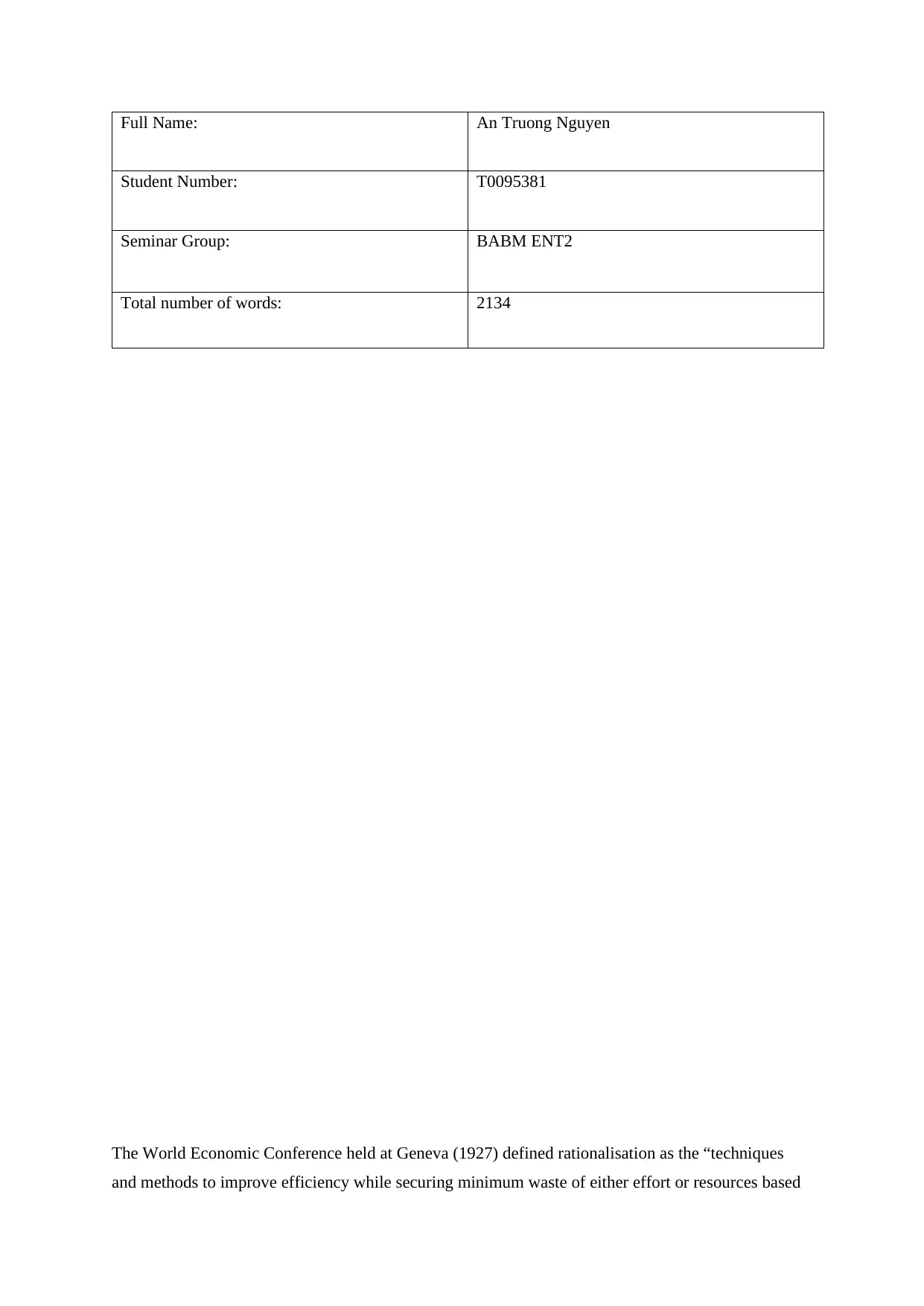
Full Name: An Truong Nguyen
Student Number: T0095381
Seminar Group: BABM ENT2
Total number of words: 2134
The World Economic Conference held at Geneva (1927) defined rationalisation as the “techniques
and methods to improve efficiency while securing minimum waste of either effort or resources based
Student Number: T0095381
Seminar Group: BABM ENT2
Total number of words: 2134
The World Economic Conference held at Geneva (1927) defined rationalisation as the “techniques
and methods to improve efficiency while securing minimum waste of either effort or resources based
Paraphrase This Document
Need a fresh take? Get an instant paraphrase of this document with our AI Paraphraser
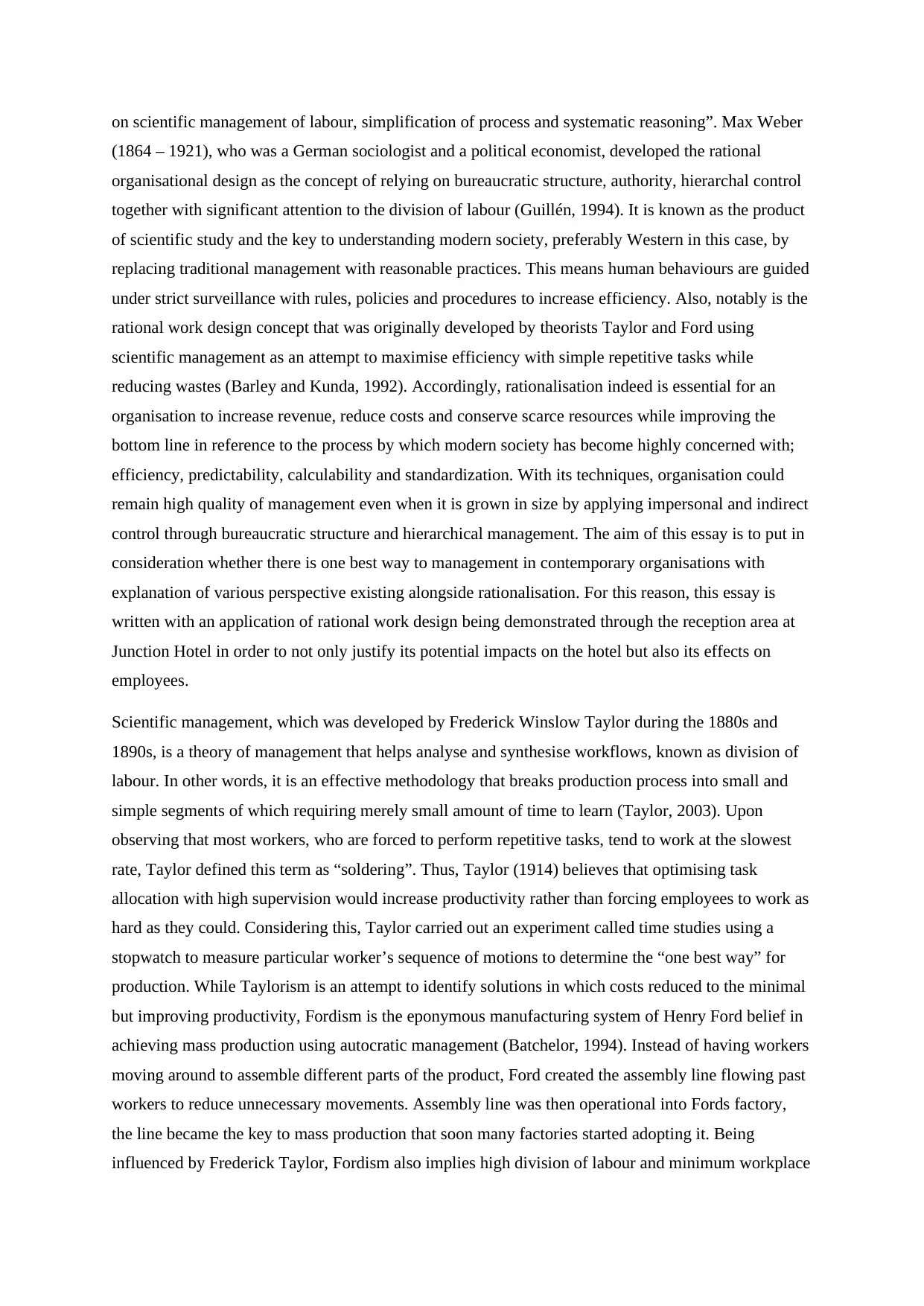
on scientific management of labour, simplification of process and systematic reasoning”. Max Weber
(1864 – 1921), who was a German sociologist and a political economist, developed the rational
organisational design as the concept of relying on bureaucratic structure, authority, hierarchal control
together with significant attention to the division of labour (Guillén, 1994). It is known as the product
of scientific study and the key to understanding modern society, preferably Western in this case, by
replacing traditional management with reasonable practices. This means human behaviours are guided
under strict surveillance with rules, policies and procedures to increase efficiency. Also, notably is the
rational work design concept that was originally developed by theorists Taylor and Ford using
scientific management as an attempt to maximise efficiency with simple repetitive tasks while
reducing wastes (Barley and Kunda, 1992). Accordingly, rationalisation indeed is essential for an
organisation to increase revenue, reduce costs and conserve scarce resources while improving the
bottom line in reference to the process by which modern society has become highly concerned with;
efficiency, predictability, calculability and standardization. With its techniques, organisation could
remain high quality of management even when it is grown in size by applying impersonal and indirect
control through bureaucratic structure and hierarchical management. The aim of this essay is to put in
consideration whether there is one best way to management in contemporary organisations with
explanation of various perspective existing alongside rationalisation. For this reason, this essay is
written with an application of rational work design being demonstrated through the reception area at
Junction Hotel in order to not only justify its potential impacts on the hotel but also its effects on
employees.
Scientific management, which was developed by Frederick Winslow Taylor during the 1880s and
1890s, is a theory of management that helps analyse and synthesise workflows, known as division of
labour. In other words, it is an effective methodology that breaks production process into small and
simple segments of which requiring merely small amount of time to learn (Taylor, 2003). Upon
observing that most workers, who are forced to perform repetitive tasks, tend to work at the slowest
rate, Taylor defined this term as “soldering”. Thus, Taylor (1914) believes that optimising task
allocation with high supervision would increase productivity rather than forcing employees to work as
hard as they could. Considering this, Taylor carried out an experiment called time studies using a
stopwatch to measure particular worker’s sequence of motions to determine the “one best way” for
production. While Taylorism is an attempt to identify solutions in which costs reduced to the minimal
but improving productivity, Fordism is the eponymous manufacturing system of Henry Ford belief in
achieving mass production using autocratic management (Batchelor, 1994). Instead of having workers
moving around to assemble different parts of the product, Ford created the assembly line flowing past
workers to reduce unnecessary movements. Assembly line was then operational into Fords factory,
the line became the key to mass production that soon many factories started adopting it. Being
influenced by Frederick Taylor, Fordism also implies high division of labour and minimum workplace
(1864 – 1921), who was a German sociologist and a political economist, developed the rational
organisational design as the concept of relying on bureaucratic structure, authority, hierarchal control
together with significant attention to the division of labour (Guillén, 1994). It is known as the product
of scientific study and the key to understanding modern society, preferably Western in this case, by
replacing traditional management with reasonable practices. This means human behaviours are guided
under strict surveillance with rules, policies and procedures to increase efficiency. Also, notably is the
rational work design concept that was originally developed by theorists Taylor and Ford using
scientific management as an attempt to maximise efficiency with simple repetitive tasks while
reducing wastes (Barley and Kunda, 1992). Accordingly, rationalisation indeed is essential for an
organisation to increase revenue, reduce costs and conserve scarce resources while improving the
bottom line in reference to the process by which modern society has become highly concerned with;
efficiency, predictability, calculability and standardization. With its techniques, organisation could
remain high quality of management even when it is grown in size by applying impersonal and indirect
control through bureaucratic structure and hierarchical management. The aim of this essay is to put in
consideration whether there is one best way to management in contemporary organisations with
explanation of various perspective existing alongside rationalisation. For this reason, this essay is
written with an application of rational work design being demonstrated through the reception area at
Junction Hotel in order to not only justify its potential impacts on the hotel but also its effects on
employees.
Scientific management, which was developed by Frederick Winslow Taylor during the 1880s and
1890s, is a theory of management that helps analyse and synthesise workflows, known as division of
labour. In other words, it is an effective methodology that breaks production process into small and
simple segments of which requiring merely small amount of time to learn (Taylor, 2003). Upon
observing that most workers, who are forced to perform repetitive tasks, tend to work at the slowest
rate, Taylor defined this term as “soldering”. Thus, Taylor (1914) believes that optimising task
allocation with high supervision would increase productivity rather than forcing employees to work as
hard as they could. Considering this, Taylor carried out an experiment called time studies using a
stopwatch to measure particular worker’s sequence of motions to determine the “one best way” for
production. While Taylorism is an attempt to identify solutions in which costs reduced to the minimal
but improving productivity, Fordism is the eponymous manufacturing system of Henry Ford belief in
achieving mass production using autocratic management (Batchelor, 1994). Instead of having workers
moving around to assemble different parts of the product, Ford created the assembly line flowing past
workers to reduce unnecessary movements. Assembly line was then operational into Fords factory,
the line became the key to mass production that soon many factories started adopting it. Being
influenced by Frederick Taylor, Fordism also implies high division of labour and minimum workplace
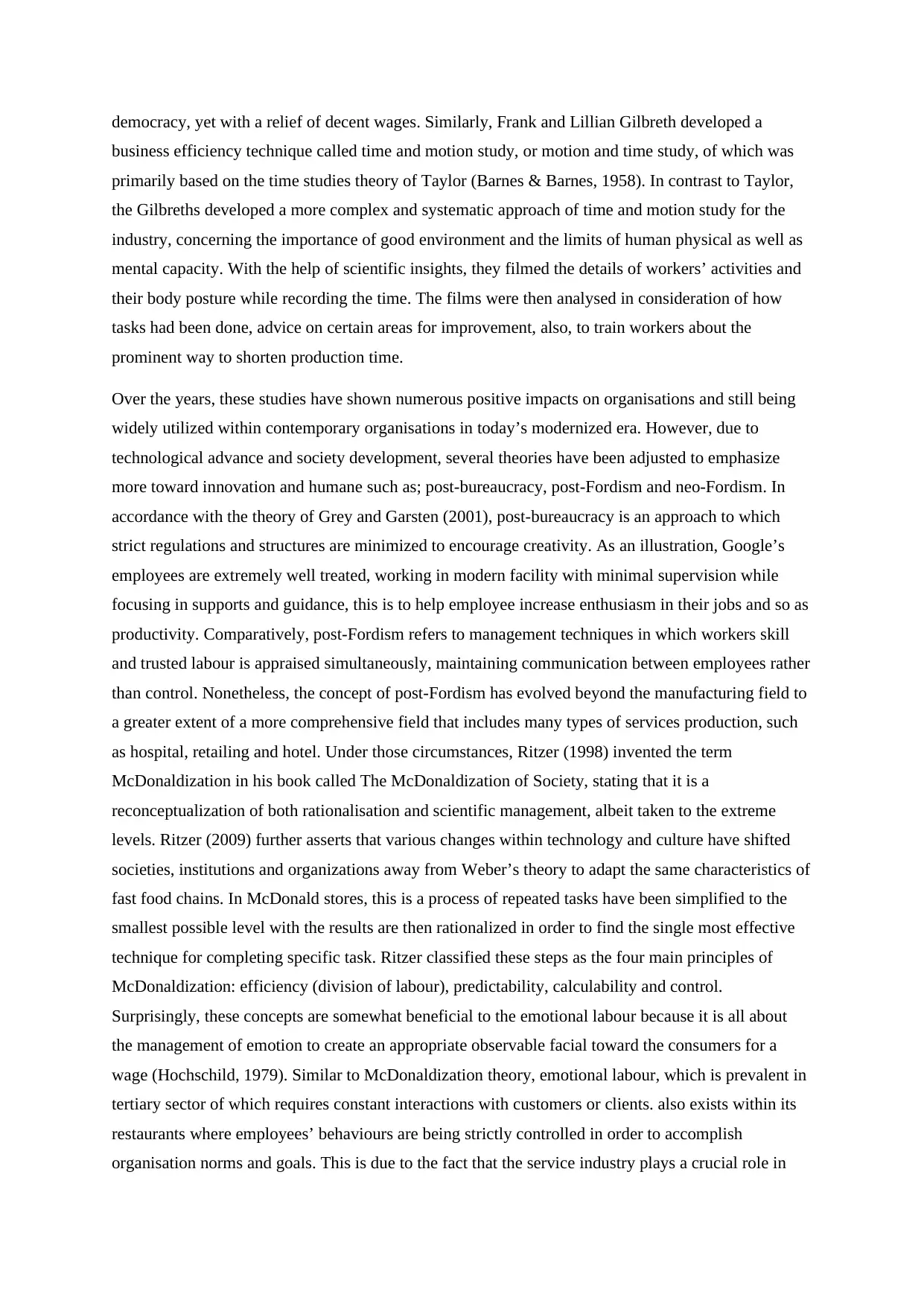
democracy, yet with a relief of decent wages. Similarly, Frank and Lillian Gilbreth developed a
business efficiency technique called time and motion study, or motion and time study, of which was
primarily based on the time studies theory of Taylor (Barnes & Barnes, 1958). In contrast to Taylor,
the Gilbreths developed a more complex and systematic approach of time and motion study for the
industry, concerning the importance of good environment and the limits of human physical as well as
mental capacity. With the help of scientific insights, they filmed the details of workers’ activities and
their body posture while recording the time. The films were then analysed in consideration of how
tasks had been done, advice on certain areas for improvement, also, to train workers about the
prominent way to shorten production time.
Over the years, these studies have shown numerous positive impacts on organisations and still being
widely utilized within contemporary organisations in today’s modernized era. However, due to
technological advance and society development, several theories have been adjusted to emphasize
more toward innovation and humane such as; post-bureaucracy, post-Fordism and neo-Fordism. In
accordance with the theory of Grey and Garsten (2001), post-bureaucracy is an approach to which
strict regulations and structures are minimized to encourage creativity. As an illustration, Google’s
employees are extremely well treated, working in modern facility with minimal supervision while
focusing in supports and guidance, this is to help employee increase enthusiasm in their jobs and so as
productivity. Comparatively, post-Fordism refers to management techniques in which workers skill
and trusted labour is appraised simultaneously, maintaining communication between employees rather
than control. Nonetheless, the concept of post-Fordism has evolved beyond the manufacturing field to
a greater extent of a more comprehensive field that includes many types of services production, such
as hospital, retailing and hotel. Under those circumstances, Ritzer (1998) invented the term
McDonaldization in his book called The McDonaldization of Society, stating that it is a
reconceptualization of both rationalisation and scientific management, albeit taken to the extreme
levels. Ritzer (2009) further asserts that various changes within technology and culture have shifted
societies, institutions and organizations away from Weber’s theory to adapt the same characteristics of
fast food chains. In McDonald stores, this is a process of repeated tasks have been simplified to the
smallest possible level with the results are then rationalized in order to find the single most effective
technique for completing specific task. Ritzer classified these steps as the four main principles of
McDonaldization: efficiency (division of labour), predictability, calculability and control.
Surprisingly, these concepts are somewhat beneficial to the emotional labour because it is all about
the management of emotion to create an appropriate observable facial toward the consumers for a
wage (Hochschild, 1979). Similar to McDonaldization theory, emotional labour, which is prevalent in
tertiary sector of which requires constant interactions with customers or clients. also exists within its
restaurants where employees’ behaviours are being strictly controlled in order to accomplish
organisation norms and goals. This is due to the fact that the service industry plays a crucial role in
business efficiency technique called time and motion study, or motion and time study, of which was
primarily based on the time studies theory of Taylor (Barnes & Barnes, 1958). In contrast to Taylor,
the Gilbreths developed a more complex and systematic approach of time and motion study for the
industry, concerning the importance of good environment and the limits of human physical as well as
mental capacity. With the help of scientific insights, they filmed the details of workers’ activities and
their body posture while recording the time. The films were then analysed in consideration of how
tasks had been done, advice on certain areas for improvement, also, to train workers about the
prominent way to shorten production time.
Over the years, these studies have shown numerous positive impacts on organisations and still being
widely utilized within contemporary organisations in today’s modernized era. However, due to
technological advance and society development, several theories have been adjusted to emphasize
more toward innovation and humane such as; post-bureaucracy, post-Fordism and neo-Fordism. In
accordance with the theory of Grey and Garsten (2001), post-bureaucracy is an approach to which
strict regulations and structures are minimized to encourage creativity. As an illustration, Google’s
employees are extremely well treated, working in modern facility with minimal supervision while
focusing in supports and guidance, this is to help employee increase enthusiasm in their jobs and so as
productivity. Comparatively, post-Fordism refers to management techniques in which workers skill
and trusted labour is appraised simultaneously, maintaining communication between employees rather
than control. Nonetheless, the concept of post-Fordism has evolved beyond the manufacturing field to
a greater extent of a more comprehensive field that includes many types of services production, such
as hospital, retailing and hotel. Under those circumstances, Ritzer (1998) invented the term
McDonaldization in his book called The McDonaldization of Society, stating that it is a
reconceptualization of both rationalisation and scientific management, albeit taken to the extreme
levels. Ritzer (2009) further asserts that various changes within technology and culture have shifted
societies, institutions and organizations away from Weber’s theory to adapt the same characteristics of
fast food chains. In McDonald stores, this is a process of repeated tasks have been simplified to the
smallest possible level with the results are then rationalized in order to find the single most effective
technique for completing specific task. Ritzer classified these steps as the four main principles of
McDonaldization: efficiency (division of labour), predictability, calculability and control.
Surprisingly, these concepts are somewhat beneficial to the emotional labour because it is all about
the management of emotion to create an appropriate observable facial toward the consumers for a
wage (Hochschild, 1979). Similar to McDonaldization theory, emotional labour, which is prevalent in
tertiary sector of which requires constant interactions with customers or clients. also exists within its
restaurants where employees’ behaviours are being strictly controlled in order to accomplish
organisation norms and goals. This is due to the fact that the service industry plays a crucial role in
⊘ This is a preview!⊘
Do you want full access?
Subscribe today to unlock all pages.

Trusted by 1+ million students worldwide
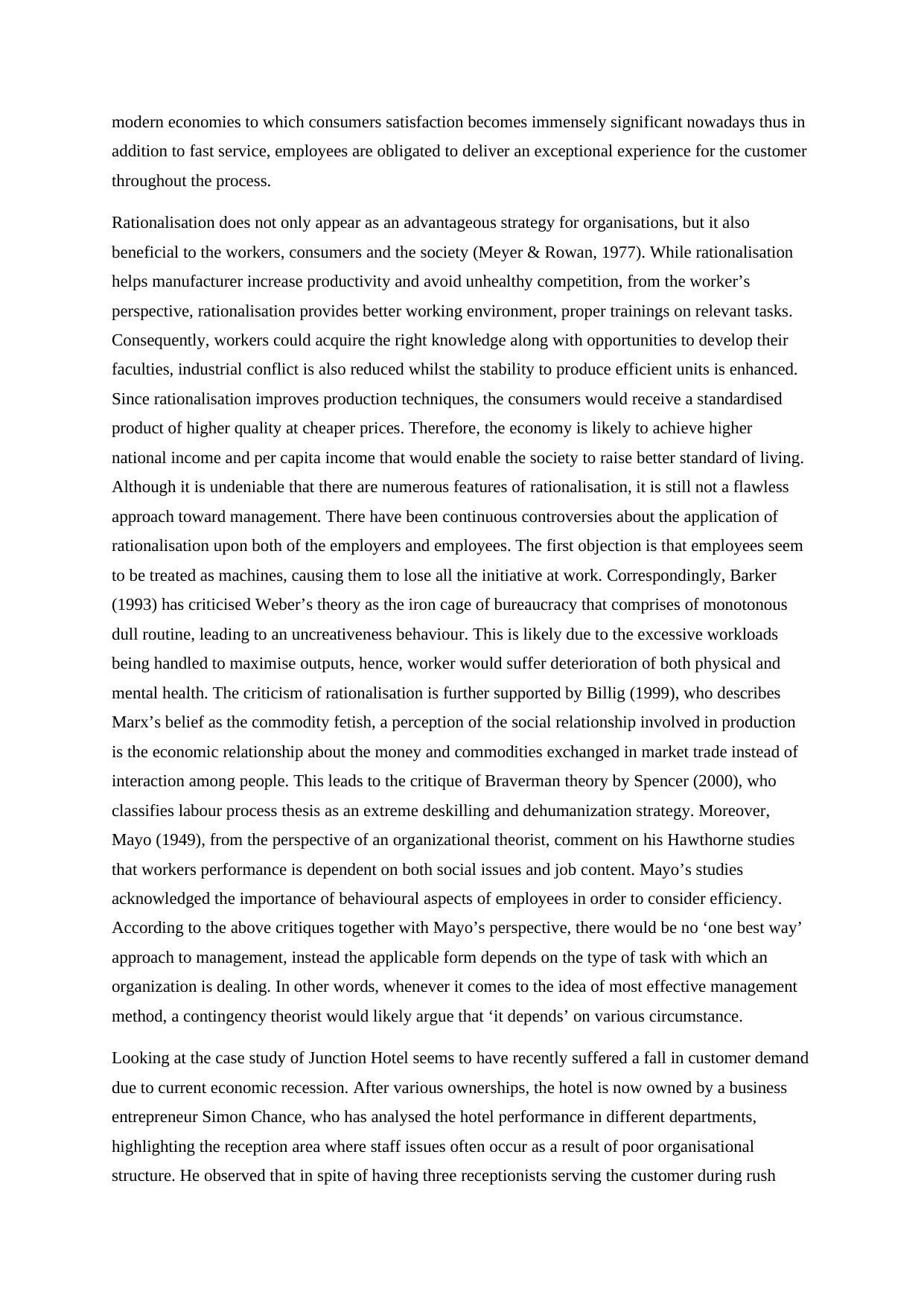
modern economies to which consumers satisfaction becomes immensely significant nowadays thus in
addition to fast service, employees are obligated to deliver an exceptional experience for the customer
throughout the process.
Rationalisation does not only appear as an advantageous strategy for organisations, but it also
beneficial to the workers, consumers and the society (Meyer & Rowan, 1977). While rationalisation
helps manufacturer increase productivity and avoid unhealthy competition, from the worker’s
perspective, rationalisation provides better working environment, proper trainings on relevant tasks.
Consequently, workers could acquire the right knowledge along with opportunities to develop their
faculties, industrial conflict is also reduced whilst the stability to produce efficient units is enhanced.
Since rationalisation improves production techniques, the consumers would receive a standardised
product of higher quality at cheaper prices. Therefore, the economy is likely to achieve higher
national income and per capita income that would enable the society to raise better standard of living.
Although it is undeniable that there are numerous features of rationalisation, it is still not a flawless
approach toward management. There have been continuous controversies about the application of
rationalisation upon both of the employers and employees. The first objection is that employees seem
to be treated as machines, causing them to lose all the initiative at work. Correspondingly, Barker
(1993) has criticised Weber’s theory as the iron cage of bureaucracy that comprises of monotonous
dull routine, leading to an uncreativeness behaviour. This is likely due to the excessive workloads
being handled to maximise outputs, hence, worker would suffer deterioration of both physical and
mental health. The criticism of rationalisation is further supported by Billig (1999), who describes
Marx’s belief as the commodity fetish, a perception of the social relationship involved in production
is the economic relationship about the money and commodities exchanged in market trade instead of
interaction among people. This leads to the critique of Braverman theory by Spencer (2000), who
classifies labour process thesis as an extreme deskilling and dehumanization strategy. Moreover,
Mayo (1949), from the perspective of an organizational theorist, comment on his Hawthorne studies
that workers performance is dependent on both social issues and job content. Mayo’s studies
acknowledged the importance of behavioural aspects of employees in order to consider efficiency.
According to the above critiques together with Mayo’s perspective, there would be no ‘one best way’
approach to management, instead the applicable form depends on the type of task with which an
organization is dealing. In other words, whenever it comes to the idea of most effective management
method, a contingency theorist would likely argue that ‘it depends’ on various circumstance.
Looking at the case study of Junction Hotel seems to have recently suffered a fall in customer demand
due to current economic recession. After various ownerships, the hotel is now owned by a business
entrepreneur Simon Chance, who has analysed the hotel performance in different departments,
highlighting the reception area where staff issues often occur as a result of poor organisational
structure. He observed that in spite of having three receptionists serving the customer during rush
addition to fast service, employees are obligated to deliver an exceptional experience for the customer
throughout the process.
Rationalisation does not only appear as an advantageous strategy for organisations, but it also
beneficial to the workers, consumers and the society (Meyer & Rowan, 1977). While rationalisation
helps manufacturer increase productivity and avoid unhealthy competition, from the worker’s
perspective, rationalisation provides better working environment, proper trainings on relevant tasks.
Consequently, workers could acquire the right knowledge along with opportunities to develop their
faculties, industrial conflict is also reduced whilst the stability to produce efficient units is enhanced.
Since rationalisation improves production techniques, the consumers would receive a standardised
product of higher quality at cheaper prices. Therefore, the economy is likely to achieve higher
national income and per capita income that would enable the society to raise better standard of living.
Although it is undeniable that there are numerous features of rationalisation, it is still not a flawless
approach toward management. There have been continuous controversies about the application of
rationalisation upon both of the employers and employees. The first objection is that employees seem
to be treated as machines, causing them to lose all the initiative at work. Correspondingly, Barker
(1993) has criticised Weber’s theory as the iron cage of bureaucracy that comprises of monotonous
dull routine, leading to an uncreativeness behaviour. This is likely due to the excessive workloads
being handled to maximise outputs, hence, worker would suffer deterioration of both physical and
mental health. The criticism of rationalisation is further supported by Billig (1999), who describes
Marx’s belief as the commodity fetish, a perception of the social relationship involved in production
is the economic relationship about the money and commodities exchanged in market trade instead of
interaction among people. This leads to the critique of Braverman theory by Spencer (2000), who
classifies labour process thesis as an extreme deskilling and dehumanization strategy. Moreover,
Mayo (1949), from the perspective of an organizational theorist, comment on his Hawthorne studies
that workers performance is dependent on both social issues and job content. Mayo’s studies
acknowledged the importance of behavioural aspects of employees in order to consider efficiency.
According to the above critiques together with Mayo’s perspective, there would be no ‘one best way’
approach to management, instead the applicable form depends on the type of task with which an
organization is dealing. In other words, whenever it comes to the idea of most effective management
method, a contingency theorist would likely argue that ‘it depends’ on various circumstance.
Looking at the case study of Junction Hotel seems to have recently suffered a fall in customer demand
due to current economic recession. After various ownerships, the hotel is now owned by a business
entrepreneur Simon Chance, who has analysed the hotel performance in different departments,
highlighting the reception area where staff issues often occur as a result of poor organisational
structure. He observed that in spite of having three receptionists serving the customer during rush
Paraphrase This Document
Need a fresh take? Get an instant paraphrase of this document with our AI Paraphraser
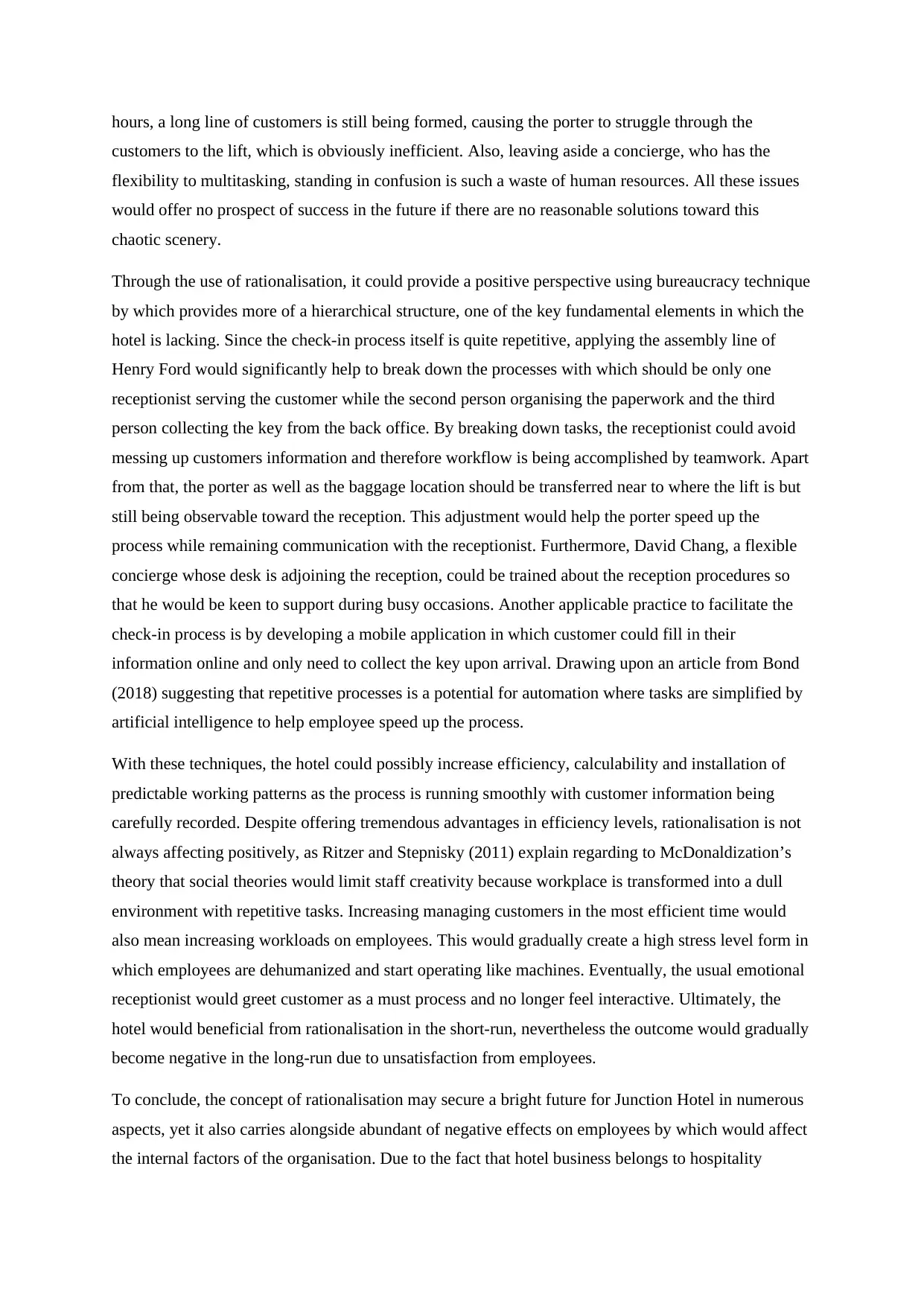
hours, a long line of customers is still being formed, causing the porter to struggle through the
customers to the lift, which is obviously inefficient. Also, leaving aside a concierge, who has the
flexibility to multitasking, standing in confusion is such a waste of human resources. All these issues
would offer no prospect of success in the future if there are no reasonable solutions toward this
chaotic scenery.
Through the use of rationalisation, it could provide a positive perspective using bureaucracy technique
by which provides more of a hierarchical structure, one of the key fundamental elements in which the
hotel is lacking. Since the check-in process itself is quite repetitive, applying the assembly line of
Henry Ford would significantly help to break down the processes with which should be only one
receptionist serving the customer while the second person organising the paperwork and the third
person collecting the key from the back office. By breaking down tasks, the receptionist could avoid
messing up customers information and therefore workflow is being accomplished by teamwork. Apart
from that, the porter as well as the baggage location should be transferred near to where the lift is but
still being observable toward the reception. This adjustment would help the porter speed up the
process while remaining communication with the receptionist. Furthermore, David Chang, a flexible
concierge whose desk is adjoining the reception, could be trained about the reception procedures so
that he would be keen to support during busy occasions. Another applicable practice to facilitate the
check-in process is by developing a mobile application in which customer could fill in their
information online and only need to collect the key upon arrival. Drawing upon an article from Bond
(2018) suggesting that repetitive processes is a potential for automation where tasks are simplified by
artificial intelligence to help employee speed up the process.
With these techniques, the hotel could possibly increase efficiency, calculability and installation of
predictable working patterns as the process is running smoothly with customer information being
carefully recorded. Despite offering tremendous advantages in efficiency levels, rationalisation is not
always affecting positively, as Ritzer and Stepnisky (2011) explain regarding to McDonaldization’s
theory that social theories would limit staff creativity because workplace is transformed into a dull
environment with repetitive tasks. Increasing managing customers in the most efficient time would
also mean increasing workloads on employees. This would gradually create a high stress level form in
which employees are dehumanized and start operating like machines. Eventually, the usual emotional
receptionist would greet customer as a must process and no longer feel interactive. Ultimately, the
hotel would beneficial from rationalisation in the short-run, nevertheless the outcome would gradually
become negative in the long-run due to unsatisfaction from employees.
To conclude, the concept of rationalisation may secure a bright future for Junction Hotel in numerous
aspects, yet it also carries alongside abundant of negative effects on employees by which would affect
the internal factors of the organisation. Due to the fact that hotel business belongs to hospitality
customers to the lift, which is obviously inefficient. Also, leaving aside a concierge, who has the
flexibility to multitasking, standing in confusion is such a waste of human resources. All these issues
would offer no prospect of success in the future if there are no reasonable solutions toward this
chaotic scenery.
Through the use of rationalisation, it could provide a positive perspective using bureaucracy technique
by which provides more of a hierarchical structure, one of the key fundamental elements in which the
hotel is lacking. Since the check-in process itself is quite repetitive, applying the assembly line of
Henry Ford would significantly help to break down the processes with which should be only one
receptionist serving the customer while the second person organising the paperwork and the third
person collecting the key from the back office. By breaking down tasks, the receptionist could avoid
messing up customers information and therefore workflow is being accomplished by teamwork. Apart
from that, the porter as well as the baggage location should be transferred near to where the lift is but
still being observable toward the reception. This adjustment would help the porter speed up the
process while remaining communication with the receptionist. Furthermore, David Chang, a flexible
concierge whose desk is adjoining the reception, could be trained about the reception procedures so
that he would be keen to support during busy occasions. Another applicable practice to facilitate the
check-in process is by developing a mobile application in which customer could fill in their
information online and only need to collect the key upon arrival. Drawing upon an article from Bond
(2018) suggesting that repetitive processes is a potential for automation where tasks are simplified by
artificial intelligence to help employee speed up the process.
With these techniques, the hotel could possibly increase efficiency, calculability and installation of
predictable working patterns as the process is running smoothly with customer information being
carefully recorded. Despite offering tremendous advantages in efficiency levels, rationalisation is not
always affecting positively, as Ritzer and Stepnisky (2011) explain regarding to McDonaldization’s
theory that social theories would limit staff creativity because workplace is transformed into a dull
environment with repetitive tasks. Increasing managing customers in the most efficient time would
also mean increasing workloads on employees. This would gradually create a high stress level form in
which employees are dehumanized and start operating like machines. Eventually, the usual emotional
receptionist would greet customer as a must process and no longer feel interactive. Ultimately, the
hotel would beneficial from rationalisation in the short-run, nevertheless the outcome would gradually
become negative in the long-run due to unsatisfaction from employees.
To conclude, the concept of rationalisation may secure a bright future for Junction Hotel in numerous
aspects, yet it also carries alongside abundant of negative effects on employees by which would affect
the internal factors of the organisation. Due to the fact that hotel business belongs to hospitality
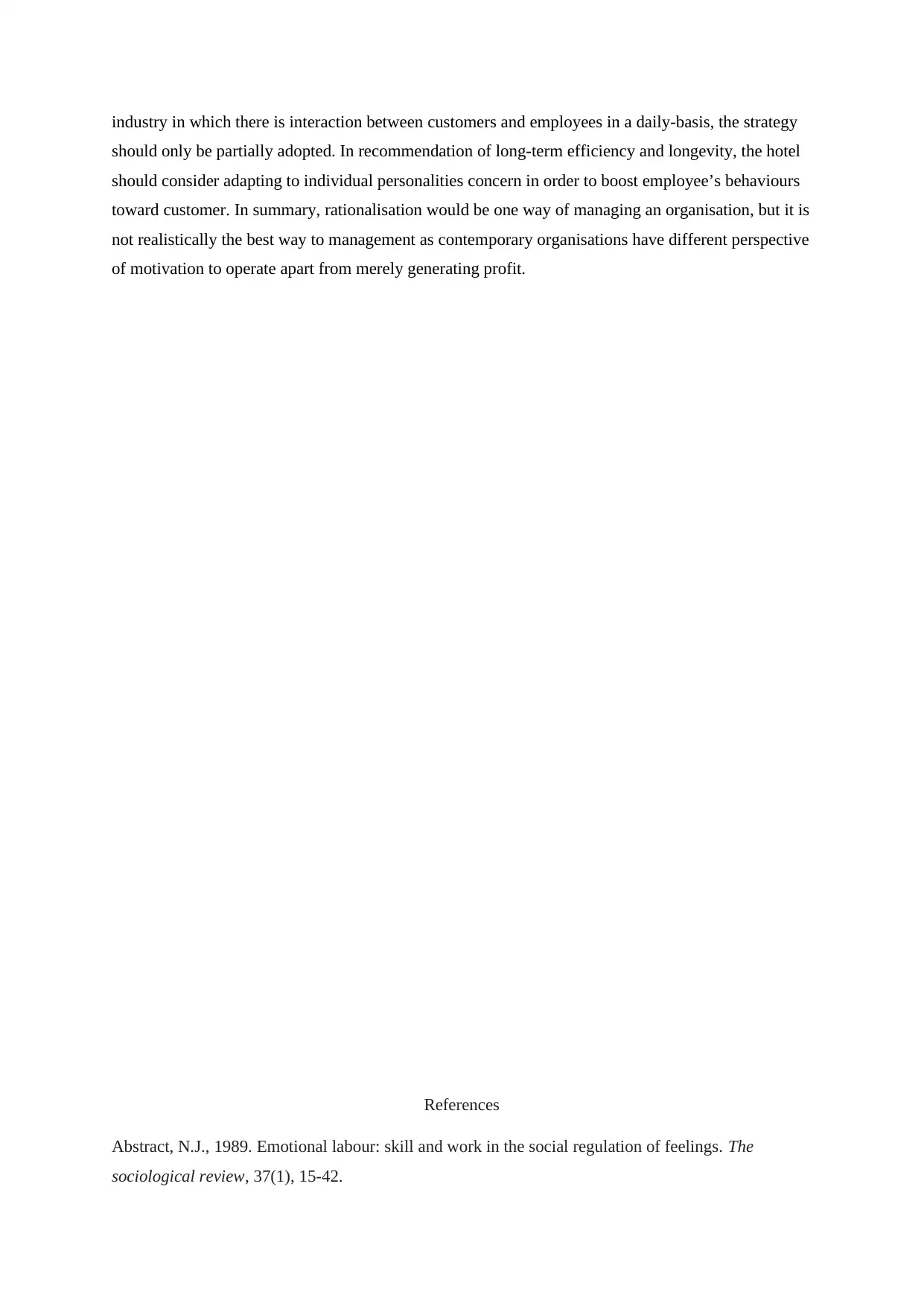
industry in which there is interaction between customers and employees in a daily-basis, the strategy
should only be partially adopted. In recommendation of long-term efficiency and longevity, the hotel
should consider adapting to individual personalities concern in order to boost employee’s behaviours
toward customer. In summary, rationalisation would be one way of managing an organisation, but it is
not realistically the best way to management as contemporary organisations have different perspective
of motivation to operate apart from merely generating profit.
References
Abstract, N.J., 1989. Emotional labour: skill and work in the social regulation of feelings. The
sociological review, 37(1), 15-42.
should only be partially adopted. In recommendation of long-term efficiency and longevity, the hotel
should consider adapting to individual personalities concern in order to boost employee’s behaviours
toward customer. In summary, rationalisation would be one way of managing an organisation, but it is
not realistically the best way to management as contemporary organisations have different perspective
of motivation to operate apart from merely generating profit.
References
Abstract, N.J., 1989. Emotional labour: skill and work in the social regulation of feelings. The
sociological review, 37(1), 15-42.
⊘ This is a preview!⊘
Do you want full access?
Subscribe today to unlock all pages.

Trusted by 1+ million students worldwide
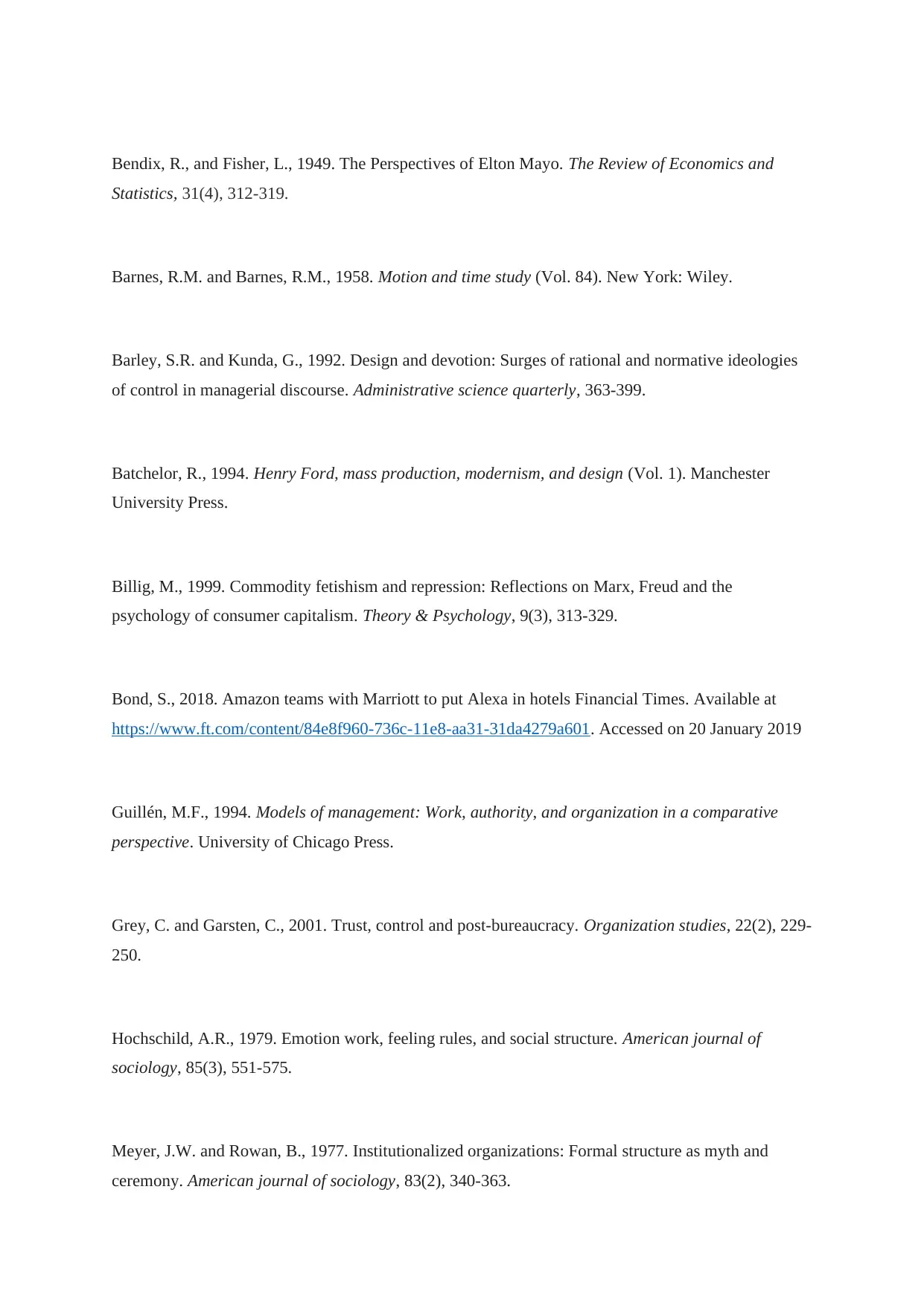
Bendix, R., and Fisher, L., 1949. The Perspectives of Elton Mayo. The Review of Economics and
Statistics, 31(4), 312-319.
Barnes, R.M. and Barnes, R.M., 1958. Motion and time study (Vol. 84). New York: Wiley.
Barley, S.R. and Kunda, G., 1992. Design and devotion: Surges of rational and normative ideologies
of control in managerial discourse. Administrative science quarterly, 363-399.
Batchelor, R., 1994. Henry Ford, mass production, modernism, and design (Vol. 1). Manchester
University Press.
Billig, M., 1999. Commodity fetishism and repression: Reflections on Marx, Freud and the
psychology of consumer capitalism. Theory & Psychology, 9(3), 313-329.
Bond, S., 2018. Amazon teams with Marriott to put Alexa in hotels Financial Times. Available at
https://www.ft.com/content/84e8f960-736c-11e8-aa31-31da4279a601. Accessed on 20 January 2019
Guillén, M.F., 1994. Models of management: Work, authority, and organization in a comparative
perspective. University of Chicago Press.
Grey, C. and Garsten, C., 2001. Trust, control and post-bureaucracy. Organization studies, 22(2), 229-
250.
Hochschild, A.R., 1979. Emotion work, feeling rules, and social structure. American journal of
sociology, 85(3), 551-575.
Meyer, J.W. and Rowan, B., 1977. Institutionalized organizations: Formal structure as myth and
ceremony. American journal of sociology, 83(2), 340-363.
Statistics, 31(4), 312-319.
Barnes, R.M. and Barnes, R.M., 1958. Motion and time study (Vol. 84). New York: Wiley.
Barley, S.R. and Kunda, G., 1992. Design and devotion: Surges of rational and normative ideologies
of control in managerial discourse. Administrative science quarterly, 363-399.
Batchelor, R., 1994. Henry Ford, mass production, modernism, and design (Vol. 1). Manchester
University Press.
Billig, M., 1999. Commodity fetishism and repression: Reflections on Marx, Freud and the
psychology of consumer capitalism. Theory & Psychology, 9(3), 313-329.
Bond, S., 2018. Amazon teams with Marriott to put Alexa in hotels Financial Times. Available at
https://www.ft.com/content/84e8f960-736c-11e8-aa31-31da4279a601. Accessed on 20 January 2019
Guillén, M.F., 1994. Models of management: Work, authority, and organization in a comparative
perspective. University of Chicago Press.
Grey, C. and Garsten, C., 2001. Trust, control and post-bureaucracy. Organization studies, 22(2), 229-
250.
Hochschild, A.R., 1979. Emotion work, feeling rules, and social structure. American journal of
sociology, 85(3), 551-575.
Meyer, J.W. and Rowan, B., 1977. Institutionalized organizations: Formal structure as myth and
ceremony. American journal of sociology, 83(2), 340-363.
Paraphrase This Document
Need a fresh take? Get an instant paraphrase of this document with our AI Paraphraser
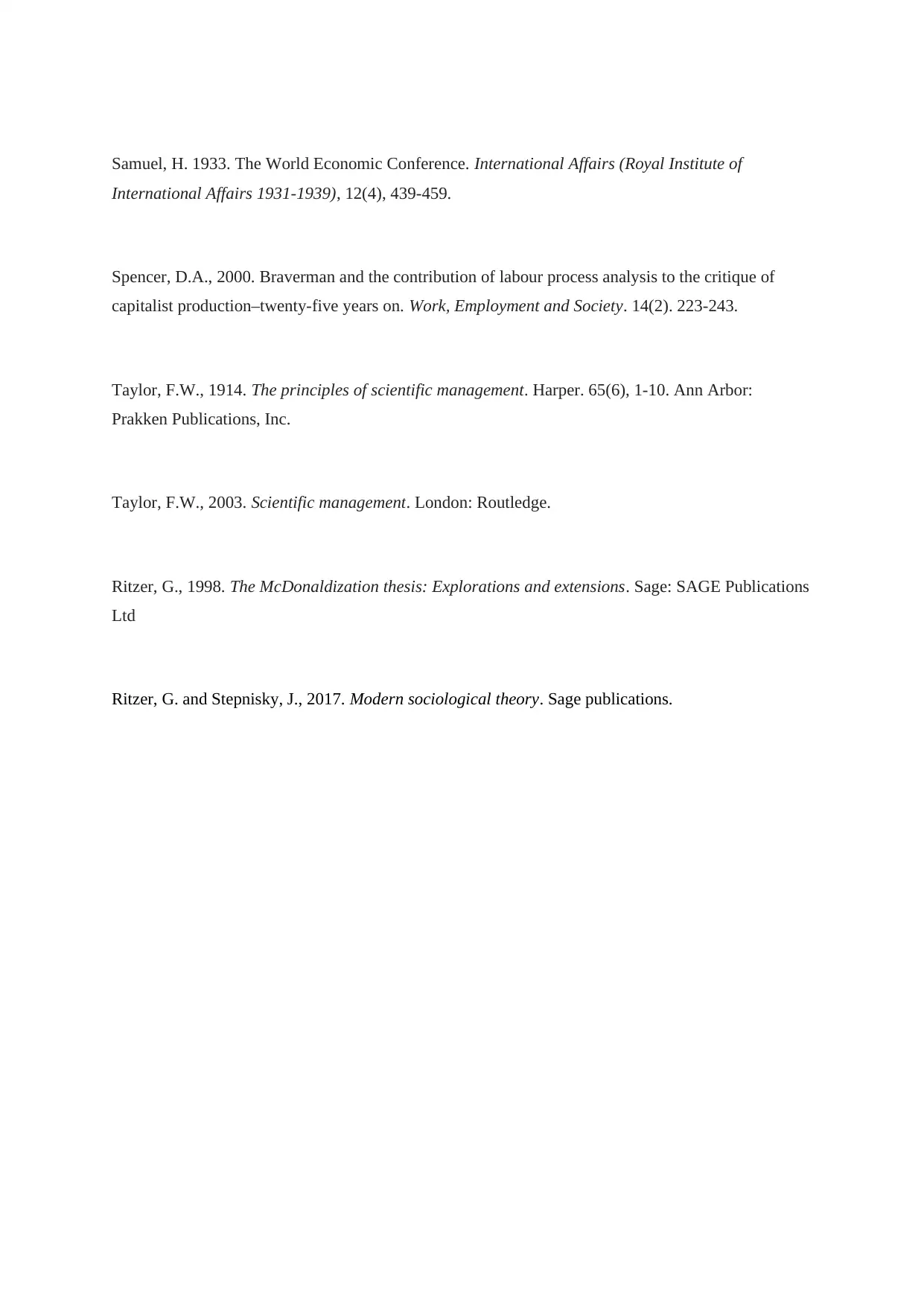
Samuel, H. 1933. The World Economic Conference. International Affairs (Royal Institute of
International Affairs 1931-1939), 12(4), 439-459.
Spencer, D.A., 2000. Braverman and the contribution of labour process analysis to the critique of
capitalist production–twenty-five years on. Work, Employment and Society. 14(2). 223-243.
Taylor, F.W., 1914. The principles of scientific management. Harper. 65(6), 1-10. Ann Arbor:
Prakken Publications, Inc.
Taylor, F.W., 2003. Scientific management. London: Routledge.
Ritzer, G., 1998. The McDonaldization thesis: Explorations and extensions. Sage: SAGE Publications
Ltd
Ritzer, G. and Stepnisky, J., 2017. Modern sociological theory. Sage publications.
International Affairs 1931-1939), 12(4), 439-459.
Spencer, D.A., 2000. Braverman and the contribution of labour process analysis to the critique of
capitalist production–twenty-five years on. Work, Employment and Society. 14(2). 223-243.
Taylor, F.W., 1914. The principles of scientific management. Harper. 65(6), 1-10. Ann Arbor:
Prakken Publications, Inc.
Taylor, F.W., 2003. Scientific management. London: Routledge.
Ritzer, G., 1998. The McDonaldization thesis: Explorations and extensions. Sage: SAGE Publications
Ltd
Ritzer, G. and Stepnisky, J., 2017. Modern sociological theory. Sage publications.
1 out of 8
Related Documents
Your All-in-One AI-Powered Toolkit for Academic Success.
+13062052269
info@desklib.com
Available 24*7 on WhatsApp / Email
![[object Object]](/_next/static/media/star-bottom.7253800d.svg)
Unlock your academic potential
Copyright © 2020–2025 A2Z Services. All Rights Reserved. Developed and managed by ZUCOL.





